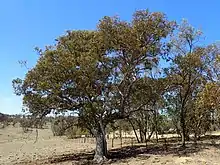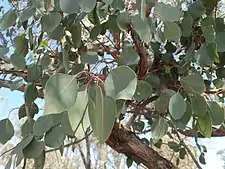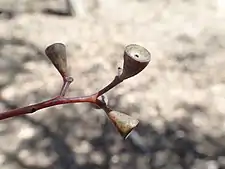| Blue box | |
|---|---|
 | |
| Eucalyptus magnificata near Hillgrove | |
| Scientific classification | |
| Kingdom: | Plantae |
| Clade: | Tracheophytes |
| Clade: | Angiosperms |
| Clade: | Eudicots |
| Clade: | Rosids |
| Order: | Myrtales |
| Family: | Myrtaceae |
| Genus: | Eucalyptus |
| Species: | E. magnificata |
| Binomial name | |
| Eucalyptus magnificata | |
Eucalyptus magnificata, commonly known as blue box[2] or northern blue box,[3] is a species of small tree or sometimes a mallee that is restricted to a small area of New South Wales. It has rough, fibrous or flaky bark on the trunk and larger branches, smooth bark above, broadly lance-shaped to egg-shaped leaves, flower buds in groups of seven, white or pale yellow flowers and conical fruit.



Description
Eucalyptus magnificata is a tree or a mallee that typically grows to a height of 8–15 m (26–49 ft) and forms a lignotuber. It has rough, fibrous or flaky bark on the trunk and larger branches, smooth greyish bark above. Young plants and coppice regrowth have egg-shaped to more or less round leaves that are 35–80 mm (1.4–3.1 in) long and 35–65 mm (1.4–2.6 in) wide. Adult leaves are broadly lance-shaped to egg-shaped, the same shade of green on both sides, 50–150 mm (2.0–5.9 in) long and 30–65 mm (1.2–2.6 in) wide, tapering to a petiole 10–30 mm (0.39–1.18 in) long. The flower buds are arranged in groups of seven, either in leaf axils or on the end of branchlets, sometimes on a branching peduncle. The peduncle is 7–13 mm (0.28–0.51 in) long and the individual buds are on pedicels 1–4 mm (0.039–0.157 in) long. Mature buds are oval, sometimes glaucous, about 5 mm (0.20 in) long and 3–5 mm (0.12–0.20 in) wide with a conical to beaked operculum. Flowering occurs in June and November and the flowers are white, pale yellow or lemon-coloured. The fruit is a woody, conical capsule 5–9 mm (0.20–0.35 in) long wide with the valves enclosed below a thin rim.[2][4][5]
Taxonomy and naming
Eucalyptus magnificata was first formally described in 1990 by Lawrie Johnson and Ken Hill from a specimen collected by Richard Cambage near Uralla in 1917.[5][6] The specific epithet (magnificata) is a Latin word meaning "magnified", referring to the leaves, buds and fruit which are larger than in related eucalypts.[5]
Distribution and habitat
Blue box grows in grassy woodland on shallow soils near Armidale in New South Wales and Stanthorpe in south-eastern Queensland.[2][4]
Conservation status
This eucalypt is classified as "endangered" under the New South Wales Government Biodiversity Conservation Act 2016.[3]
References
- ↑ "Eucalyptus macrorhyncha". Australian Plant Census. Retrieved 23 September 2019.
- 1 2 3 "Eucalyptus magnificata". Euclid: Centre for Australian National Biodiversity Research. Retrieved 1 June 2020.
- 1 2 "Northern blue box - profile". New South Wales Government Office of Environment and Heritage. Retrieved 23 September 2019.
- 1 2 Hill, Ken. "Eucalyptus magnificata". Royal Botanic Garden, Sydney. Retrieved 23 September 2019.
- 1 2 3 Johnson, Lawrence A.S.; Hill, Kenneth D. (1990). "Eucalyptus magnificata". Telopea. 4 (1): 72–74.
- ↑ "Eucalyptus magnificata". APNI. Retrieved 23 September 2019.